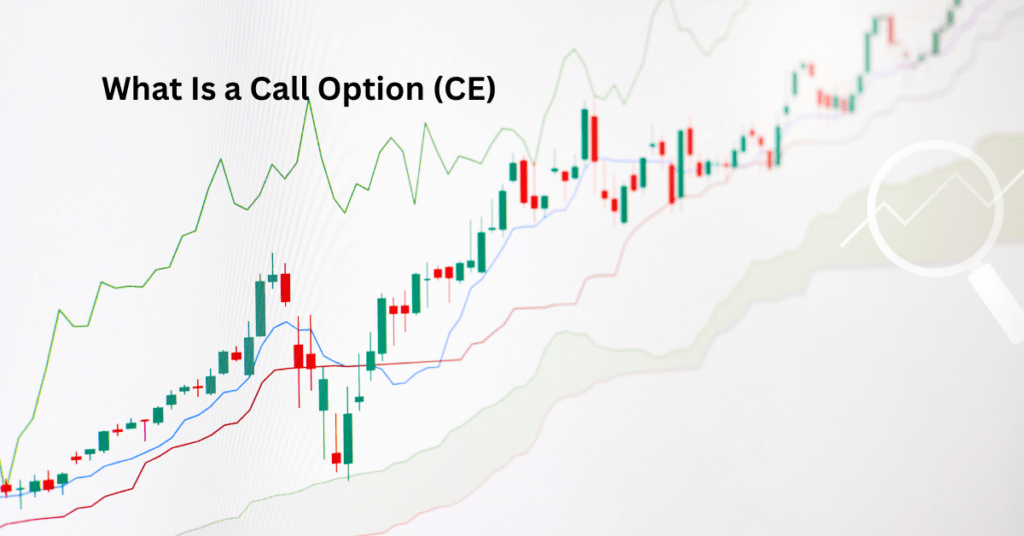If you’ve ever dipped your toes into the world of stock trading or overheard someone talking about “CE” and “PE” at a coffee shop, you might’ve wondered, “What’s all this fuss about?” Don’t worry—I’ve got you covered! Today, we’re going to unravel the mystery of CE and PE in the stock market in a way that’s simple, fun, and easy to digest.
Whether you’re a beginner or someone looking to brush up your knowledge, this guide will walk you through everything you need to know about Call Options (CE) and Put Options (PE). So, grab a cup of tea, sit back, and let’s dive into this exciting world together!
By the end of this article, you’ll not only understand what CE and PE mean but also how they work, how you can profit from them, and what to watch out for. Let’s get started!
Understanding Call (CE) and Put (PE) Options in the Stock Market
Imagine you’re at a fruit market. You see a juicy mango, and you think, “Wow, I bet the price of this mango will go up next week!” So, you strike a deal with the seller: you’ll buy it later at today’s price, no matter how high the price shoots up.
Now, picture another scenario—you’re worried the price of that mango might crash, so you make a deal to sell it at today’s price, even if it drops later. That, my friend, is the basic idea behind CE and PE in the stock market!
In the financial world, CE stands for Call Option, and PE stands for Put Option. These are tools (called “options”) that traders use to bet on whether a stock’s price will rise or fall.
They’re like little contracts that give you the right—but not the obligation—to buy or sell a stock at a set price within a certain time. Cool, right? Let’s break it down further.
MUST READ: what is GMP (Grey Market Premium ) in IPO
PE and CE Full Form in Share Market
First things first—what do CE and PE stand for? It’s pretty straightforward:

CE: Call Option
PE: Put Option
These terms come from the world of options trading, which is a part of the stock market where people trade contracts instead of directly buying or selling stocks. Think of CE and PE as your tickets to play a game of prediction with stock prices!
What Is a Call Option (CE)?

A Call Option, or CE, is like a “buy now, profit later” ticket. When you buy a CE, you’re betting that the price of a stock will go up. It gives you the right to buy a stock at a specific price (called the “strike price”) before the option expires.
If the stock’s price rises above that strike price, you can buy it cheap and sell it at the higher market price—cha-ching, profit!
For example, let’s say you buy a CE for Reliance Industries at a strike price of ₹2,500, and it costs you ₹50 (this cost is called the “premium”). If the stock jumps to ₹2,700 before the option expires, you can buy it at ₹2,500 and sell it at ₹2,700, pocketing a neat profit (minus the premium).
But if the price stays below ₹2,500, you can just let the option expire and only lose the ₹50 premium. No biggie!
What Is a Put Option (PE)?

Now, a Put Option, or PE, is the opposite—it’s your “sell now, profit later” ticket. When you buy a PE, you’re betting that the stock’s price will drop. It gives you the right to sell a stock at a specific strike price before the option expires.
If the stock’s price falls below that strike price, you can sell it at the higher strike price and make money.
Let’s take an example. Suppose you buy a PE for Tata Motors at a strike price of ₹500, and the premium is ₹30.
If the stock falls to ₹450, you can buy it at ₹450 in the market and sell it at ₹500 using your PE contract—boom, profit! But if the price stays above ₹500, you let the option expire and only lose the ₹30 premium.
What Is PE and CE in Stock Market? Explained with Example
Still confused about CE and PE? Let’s make it super simple with a real-life-ish example. Imagine you’re eyeing a stock called “ABC Ltd.,” currently trading at ₹100.
CE Example: You buy a CE with a strike price of ₹100 for a premium of ₹5. You’re hoping ABC Ltd. will rise. A week later, it jumps to ₹120. You exercise your CE, buy the stock at ₹100, and sell it at ₹120. Your profit? ₹120 – ₹100 – ₹5 (premium) = ₹15 per share. Sweet deal!
PE Example: You buy a PE with a strike price of ₹100 for a premium of ₹5, betting ABC Ltd. will fall. A week later, it drops to ₹80.
You buy the stock at ₹80 in the market, sell it at ₹100 using your PE, and pocket ₹100 – ₹80 – ₹5 = ₹15 per share. Another win!
In short, CE and PE are like two sides of a coin—one profits when prices go up, the other when prices go down. Exciting, isn’t it?
Key Differences Between CE and PE Options
Now that you’ve got the basics, let’s see how CE and PE stack up against each other. Here’s a quick rundown:
Direction of Bet: CE bets on a price increase, while PE bets on a price decrease.
Right Granted: CE gives you the right to buy, PE gives you the right to sell.
Market Mood: CE buyers are usually optimistic (bullish), while PE buyers are pessimistic (bearish).
Profit Potential: Both can make money, but it depends on how the stock moves—up for CE, down for PE.
Think of CE and PE as your trading superpowers: one lets you soar with rising stocks, the other helps you profit when the market dips. Which one will you wield?
How to Profit from CE and PE Options
So, how do you actually make money with CE and PE? It’s all about timing and prediction. When you buy a CE or PE, you pay a premium upfront. Your profit depends on whether the stock moves in your favor enough to cover that premium and then some.
For CE: The stock price needs to rise above the strike price + premium. The higher it goes, the more you earn!
For PE: The stock price needs to fall below the strike price – premium.
The lower it drops, the bigger your payout!
The beauty of CE and PE is that you don’t need to own the stock to trade them. You’re just trading the contract, which makes it a flexible and low-cost way to play the market. But here’s the catch—you’ve got to be right about the direction and timing, or you’ll lose that premium.
Must read: Exploring the Tata Gold ETF
Factors That Affect the Price of CE and PE Options
Ever wondered why the premium of CE and PE keeps changing? It’s not random! Several factors influence the price of these options:
Stock Price Movement: If the stock moves closer to your strike price (or beyond), the CE or PE premium rises.
Time Left: Options lose value as they near expiry (this is called “time decay”). More time = higher premium.
Volatility: If the stock is wild and unpredictable, CE and PE premiums shoot up because the chance of big moves increases.
Interest Rates: Higher rates can nudge premiums up slightly.
Dividends: If a stock pays dividends, it can lower CE prices and raise PE prices.
It’s like a recipe—mix these ingredients, and you get the premium price. Understanding this can help you pick the right CE or PE at the right time!
Trading Strategies for CE and PE Options
Ready to trade CE and PE like a pro? Here are some popular strategies to get you started:
Buying a CE: Go for this when you’re confident a stock will rise. It’s simple and has unlimited profit potential if the stock soars.
Buying a PE: Use this when you’re sure a stock will tank. It’s a great way to profit in a falling market.
Covered Call: Own a stock? Sell a CE against it to earn extra premium income.
Protective Put: Worried about a stock you own crashing? Buy a PE to lock in a selling price.
When to Buy PE and CE
Timing is everything!
Buy CE: When you see a stock breaking out, good news hitting the market, or a bullish trend forming.
Buy PE: When bad news looms, a stock’s overvalued, or a bearish trend kicks in.
It’s like reading the weather—spot the signs, and you’ll know whether to grab a CE or PE!
Risks and Rewards of Trading CE and PE Options
Trading CE and PE is a rollercoaster—thrilling, but not without bumps. Let’s weigh the pros and cons.
Risks of Trading CE and PE
Limited Time: If the stock doesn’t move your way before expiry, you lose the premium.
Leverage: CE and PE can amplify losses as well as gains—small moves can wipe out your investment.
Prediction Pressure: You need to be right about direction, timing, and magnitude. Tough call!
Rewards of Trading CE and PE
High Returns: A small premium can lead to big profits if the stock moves sharply.
Flexibility: Profit in rising or falling markets—CE for up, PE for down.
Low Cost: You don’t need to buy the stock outright, making it budget-friendly.
It’s a high-stakes game, but the rewards can be worth it if you play smart!
Must read: What is CPSE ETF: A Simple Guide to Smart Investing
Tips for Investing in CE and PE Options
Want to ace CE and PE trading? Here are some golden nuggets of advice:
Start Small: Test the waters with a small investment before going big.
Learn the Market: Study stock trends, news, and charts to make informed bets.
Set a Budget: Only trade what you can afford to lose—premiums can vanish fast!
Use Stop Losses: Protect yourself from big losses by setting exit points.
Practice Patience: Don’t rush into trades; wait for the right opportunity.
Think of it like planting a seed—nurture it with care, and it’ll grow into something fruitful!
Benefits of Trading CE and PE Options
Why bother with CE and PE? Here’s why traders love them:
Leverage: Control a big stock position with a small premium.
Versatility: Profit whether the market rises or falls.
Risk Control: Your max loss is limited to the premium you pay.
Hedging: Use PE to protect your stocks or CE to boost income.
It’s like having a Swiss Army knife for trading—CE and PE give you tools for every situation!
Conclusion
And there you have it—your complete guide to CE and PE in the stock market! We’ve journeyed through what Call Options (CE) and Put Options (PE) are, how they work, and how you can use them to profit.
Whether you’re betting on a stock to climb with a CE or bracing for a fall with a PE, these options open up a world of possibilities. Sure, they come with risks, but with the right knowledge and strategy, the rewards can be pretty sweet.
So, what do you think—ready to give CE and PE a shot? Start small, stay curious, and who knows? You might just find yourself hooked on the thrill of options trading. Happy trading, and may the market odds be ever in your favor!
FAQs: Everything You Need to Know About CE and PE in the Stock Market
Q1: What’s the difference between CE and PE?
A: CE (Call Option) lets you buy a stock at a set price if it rises, while PE (Put Option) lets you sell it if it falls. CE is for bullish bets, PE for bearish ones!
Q2: Can I lose more than my premium in CE and PE?
A: Nope! When you buy CE or PE, your max loss is the premium you pay. Selling options, though, is a different story—risks can be higher.
Q3: How do I choose between CE and PE?
A: It depends on your market outlook. Expect a stock to rise? Go for CE. Think it’ll drop? Pick PE. Research and gut instinct are your best friends!
Q4: Are CE and PE only for experts?
A: Not at all! Beginners can start with small trades and learn as they go. Just take it slow and study up.
Q5: How long do CE and PE options last?
A: They have an expiry date—could be a week, a month, or more. If the stock doesn’t move your way by then, the option expires worthless.
Riyo is a Digital Marketing expert with specialization in SEO and Market Analysis. He has hands-on experience in keyword research, on-page & off-page SEO, and data-driven marketing strategies. Riyo helps businesses boost their online visibility and grow through smart digital tactics.


